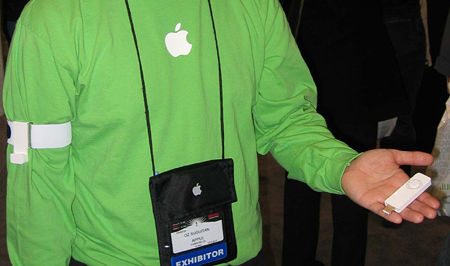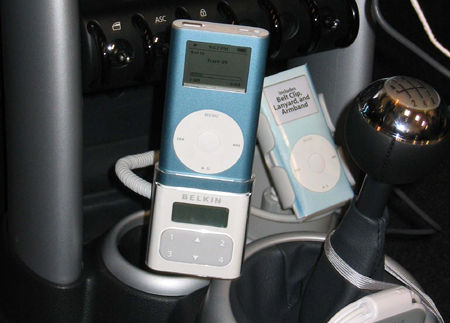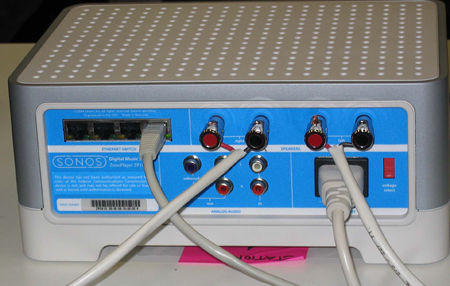| Columns Retired Columns & Blogs |
Audio Abounds at Macworld Expo
The Consumer Electronics Show (CES) in Las Vegas is not the only major electronics event held in early January each year. Apple Computer and allied companies throw their own specialty shindig more or less concurrently.
This year's Macworld Expo, held January 11–14 at the Moscone Center in San Francisco, wasn't simply devoted to the latest twist on Mac OSX or tutorials on Photoshop CS. Approximately 40,000 Apple faithful paid $40 each to ogle the newest products from Apple and others in the same hall that had hosted the Audio Engineering Society's convention just a few months earlier.
In some ways, Macworld was a continuation of AES, with an amazing assortment of audio products. Nowhere was a tube amp to be found, but contrary to end-of-the-world pronouncements made by traditionalists, audio is alive and well. Today's music fans are just as involved with music as their predecessors, but rather than sitting quietly in the sweet spot spinning vinyl, they want their music with them all the time. Music to go is obviously now the name of the game.
No one knows that better than Apple CEO Steve Jobs and his battalion of designers, whose latest contribution to portable music—and to the growing iTunes empire—is a little device called the iPod Shuffle. Essentially a USB flash-memory stick with a headphone jack and some function buttons, the $99 Shuffle was the hottest product at Macworld. People stood 10 and 12 deep to try the little players, arrayed on a huge display board at the hall's entrance. (And, when Steve Jobs mentioned that the nearby Apple store had stock on hand, there was a rush to purchase the flash players that had one witness marveling, "You'd have thought they were giving them away.")

About the size of a Magic Marker, the iPod Shuffle has a 512-megabyte solid-state memory with claimed capacity of 240 songs (assuming average song length of four minutes and using 128kbps AAC encoding), 12-hour battery life, and unprecedented ease-of-use. Its contents can be changed, and its battery recharged, by simply plugging it into a USB port on your computer. A control wheel on one side enables basic play functions, a three-position switch on the other selects on/off, random play, or linear play (delivering a playlist in predetermined order). There's no display as on the bigger iPod and iPod Mini, but that shouldn't be a problem for most potential buyers, who are likely to reload the Shuffle frequently for short outings. Included earbuds plug into the bottom of the little player; a lanyard clips to the top for easy portability. Apple plans to have a one-gigabyte version of the iPod Shuffle available soon for $149, according to a company rep on the show floor. The noisy hall made it impossible to ascertain audio quality—I tried several of the little players—but it wasn't bad.
The iPod is by far the biggest audio news in recent memory. The product totally dominates the market for portable audio devices, and helped Apple achieve a new quarterly record in sales and profits. On Wednesday, January 12, Apple reported that its revenue for the first fiscal quarter, ended December 25, was $3.5 billion, with $295 million in profits. The company sold approximately 4.6 million iPods in the most recent quarter, and approximately 10 million since the product went on sale in autumn of 2001. The value of Apple's stock tripled last year on the strength of the iPod and the popularity of iTunes.
Several other companies are riding the iPod wave, most of them making clever accessories for the portable player. Clarion had some sleek iPod products on display at Macworld, and JBL showed several iPod-based desktop audio systems, all of them nicely designed but not sonically compelling—at least, not in the noisy large hall. The JBL booth showed repeated performances of a Sheryl Crow video on several LCD monitors with matching speakers, but the audio and video were so far out of sync that even the A/V insensitive were making comments about it. (Can we get a technician over here, please?) My vote for the cleverest iPod accessory goes to Belkin Corporation, whose "TuneBase" is a one-piece cradle, power supply, FM transmitter, and gooseneck shock absorber for both full-size and mini iPods. Belkin makes an amazing array of iPod add-ons.

Perhaps of most interest to audiophiles—or perhaps, audiophiles' spouses—was a network entertainment system by newcomer Sonos. The company's Digital Music System uses your existing computer as a source. A Sonos network server distributes signals to any number of Sonos "ZonePlayers" anywhere in your home. Each compact ZonePlayer is a digital/analog receiver with multiple connections for Cat-5 Ethernet cable, standard RCA inputs, and a pair of inboard 50Wpc amplifiers. Users control any of 32 zones via a handheld remote control with color LCD display. Sonos had several of its ZonePlayers in operation at Moscone Center, each of them driving a pair of Klipsch bookshelf speakers. The din in the hall made it impossible to hear anything other than the fact that they were working, but they provoked sufficient curiosity for further investigation. The Sonos system could be the digital answer to whole-house audio. Custom installers, take note.

- Log in or register to post comments




































